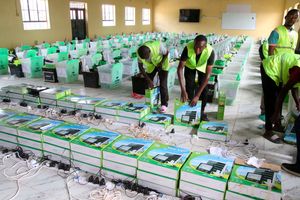Premium
Kemsa to procure 100,000 body bags as virus cases rise

The Kenya Medical Supplies Agencies headquarters in Industrial Area Nairobi. Kemsa is readying to buy the body bags. PHOTO | FILE | NATION MEDIA GROUP
What you need to know:
- On Friday, an additional 11 people succumbed to the virus in 24 hours.
The bag, which is for the adult size, 40 by 90 inches of 0.4 millimeter thickness, must have an envelope zipper and should be preferably white in colour.
Already, some counties have started preparing public graveyards in readiness for an anticipated increase in Covid-19 related deaths as coronavirus infections soar.
The government has ordered for the procurement of 100,000 Covid-19 body bags, in what is described as preparations for a “worst-case” scenario.
The development comes as the country is heading to its peak and looking at a possible increase in the number of deaths from the coronavirus disease outbreak, with the numbers currently showing 16,268 infections and 274 deaths. On Friday, an additional 11 people succumbed to the virus in 24 hours.
In a memo seen by the Sunday Nation from the Ministry of Health to Kenya Medical Supplies Agency, the bags have to be doubled bagged and be made with heavy-duty vinyl Polyvinyl chloride (PVC) plastic bag.
The bag, which is for the adult size, 40 by 90 inches of 0.4 millimeter thickness, must have an envelope zipper and should be preferably white in colour.
When the Sunday Nation contacted Kenya Medical Supplies Agency (Kemsa) chief executive Jonah Manjari Mwangi, he said the agency is waiting for approval from the Health ministry to start the process of procuring the body bags.
“We are waiting for the authority to incur expenditure. Once we have the permission from the Ministry, then we shall procure the bags,” said Dr Mwangi.
BODY BAGS
World Health Organization (WHO) director-general Tedros Adhanom Ghebreyesus warned that there will be many more “body bags” if countries did not behave asking them to stop politicising the pandemic and focus on containing the pandemic.
“Now is the time for unity, for the international community to work together in solidarity to stop this virus and its shattering consequences. We do not want to record more deaths,” the WHO chief said.
According to a projection released by scientists, the country is likely to lose 620,500 people by next year February if no sufficient measures are taken and the virus hit its peak.
In the worst scenario, the model projects that about two million Kenyans, which translates to 88 per cent of the population will be asymptomatic and about 356,000 people moderately affected by the virus.
On the severe side, 114,470 individuals will need serious attention including the intensive care unit and ventilators during the same period, this is if the measures put in place by the government are relaxed.
“The projections are not fixed and are based on the current measures and how Kenyans are willing to adhere. Behaviour change will determine the change in the modelling as well,” said Prof Omu Anzala, a microbiologist, who was also part of the disease modelling.
PUBLIC GRAVEYARDS
Already, some counties have started preparing public graveyards in readiness for an anticipated increase in Covid-19 related deaths as coronavirus infections soar.
In Kisii, Siaya, and Kakamega, leaders have already identified large swathes of land for the same.
The Kakamega governor said his county had identified two parcels of land for mass graves.
In Kisii County, officials from the National Multi-Agency Covid-19 Command Centre visited last week to discuss with the county leadership about their preparedness to deal with fatalities. The team was informed that the county has set aside a 13-acre piece of land at Nyatieko in Kitutu Chache South to be used as a cemetery.
In Siaya, health executive Dorothy Owino said the county had bought sufficient body bags. Land executive Adrian Ouma said six acres have been set aside in Sega, four acres in Siaya town while Ugunja, Rarieda, Gem and Bondo sub-counties have one acre each.
The Laikipia County government has bought enough body bags to take care of a rise in deaths, Health executive Lenai Kamario told the Nation on Monday, adding that the burial grounds were adequate.
Health chief administrative Secretary Rashid Aman on Monday said infections are likely to peak late August or early September warning of a difficult period ahead.
The gravity of the pandemic has jolted counties in the wake of the spiralling infections, with attention shifting to the worst scenario in which many lives maybe lost.
Council of Governors chairman Wycliffe Oparanya has sounded a warning about the challenge ahead for counties, expressing fears that the number of deaths may rise.
NUMBERS INCREASE
However, as the numbers increase, a key national government official has revealed to the Sunday Nation that only five counties are ready to handle the surge in the numbers.
This development came after President Uhuru Kenyatta sent his team quality control team to the ground to access counties preparedness.
The five include Kiambu, Machakos, Mombasa Murang’a and Kakamega.
This puts the remaining counties in an awkward state, hoodwinking Kenyans yet they are not implementing the directive by the government.
In the last statement, Mr Oparanya, mentioned that 26 counties were ready with the 300-bed capacity, he relied on the governors to give the numbers.
“The chair has now declared that each governor is going to defend themselves and he is not going to talk on their behalf as far as the bed capacity directive is concerned,” said the official.





